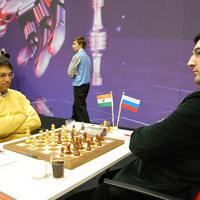
The Petroff Derailed by GM Magesh and GM Arun
Petroff's Defense is one hard nut to crack when Black plays with a proper understanding. It guarantees solid play for Black without any longterm weaknesses and that is precisely the reason why we see so many Petroff games played at the top level. However, like the Catalan we saw last week, it does offer White a tiny lasting advantage that can be a nagging problem at times. A few weeks back we studied games from Kramnik, Gelfand and Gashimov in this opening, and since there is plenty going on in this opening at the top level we decided to revisit it again this week.
After a player makes nine straight draws you really do not expect much from that player in a thirteen round tournament, even if that player is the World Champion. Speaking from a purely theoretical point of view, Vishy Anand did have the White pieces against some players about 100 FIDE points lower rated than he, but we are talking about a Super Grand Master's tournament where noone is truly "weak".
Facing a Petroff from the mighty Kramnik himself, Anand did manage to find a way to crack this hard nut. Let us take a look at a game played less than one week ago in Corus.
One of the main positions that can arise out of the Petroff Defense. Before we go any further we can just take a look at the pawn structure and the piece positions and discuss them in words.
-
Black, as we discussed earlier, has come out with an intact pawn structure allowing no real weakness for White to attack.
-
White on the other hand has a shattered pawn structure on the queen side but that has given him a really strong center('c' and 'd' pawns). If White manages to get c4 and d5 in at the right time it would give him plenty of space.
-
White has a semi open 'b' file, but that has been kept in check by Black's light squared bishop on f5
With most things being even, the main struggle continues to be the menacing central pawns that White possesses. The rest of the game depends on how Black can neutralize those pawns or how White can use them to obtain a space advantage.
There is one important thing you must keep in mind here if you are White. Allowing a blockade on c4 and allowing the exchange of the light squared bishops at the same time would be one of the worst possible things to do next to handing down your opponent some free material in a tactic.
This position shows tremendous improvements for White, but none for Black. The White rooks are centralized and the strong center is still intact while Black's pieces are struggling to find squares due to lack of space. This puts White very much in his comfort zone.
Whether his loss at the World Championship last year to Anand was still fresh in Kramnik's mind during this game is uncertain, but one thing for sure is that he was quite easily outplayed here and that is something we do not see very often. I am sure that Kramnik, being such a solid player and a really hard worker, has already figured out a way to fix this minor hitch. Let us look forward to learning a lot more from these Masters.






